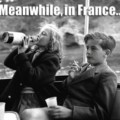"Moment blanc"
- This topic has 14 replies, 2 voices, and was last updated 3 years, 8 months ago by
 Oscar.
Oscar.
-
AuthorPosts
-
November 8, 2021 at 9:11 pm #14595
 OscarParticipant
OscarParticipant@itsnatural : although Rameau is not obscure, he’s total baroque. Murica as seen from Versailles, 1735. The piece was a reference to the visit by the chief Chicagou ten years earlier to pledge allegiance to Louis XV and to recognize his sovereignity over the Great Lakes area. I particulary appreciate this colorful rendition. I suppose the choice of costumes would be just impossible in CancelUS so, enjoy
XIV – Jean-Philippe Rameau – France – Les Indes galantes (Les sauvages – Rondeau) – 1735 – Patricia Petibon/Nicolas Rivencq, dir. William Christie
October 14, 2021 at 10:10 am #14439ItsNatural
Participant@Thanks Oscar for the music and videos. Although I have tried to listen to classical throughout the years and did enjoy it to varying smaller degrees, I am finally enjoying it and appreciating the most recently. So this is much appreciated, especially more obscure composers than Beethoven, Chopin, etc. Also, I want to get into more Baroque era and before in all of Europe.
October 12, 2021 at 7:45 pm #14426 OscarParticipant
OscarParticipantXIII – Richard Wagner – Deutschland – Rienzi (Ouvertüre) – 1842
June 8, 2021 at 9:08 pm #13501 OscarParticipant
OscarParticipantXII – Henry Purcell – England – Funeral sentences and Music for the death of the Queen Mary (March) – Z.860 – 1695
June 20, 2020 at 6:17 pm #10584 OscarParticipant
OscarParticipantXI – Léo Delibes – France – Duo des fleurs (Lakmé) – 1881 – Orchestra Les Siècles (dir. François Xavier Roth). Soprano Sabine Devielhe, mezzo-soprano Marianne Crebassa.
March 30, 2020 at 3:50 pm #9925 OscarParticipant
OscarParticipantLockdown performance from the musicians of the Orchestre national de France on Ravel’s Boléro
the complete piece :
X – Maurice Ravel – France – Boléro – 1928
March 26, 2020 at 3:35 pm #9878 OscarParticipant
OscarParticipantIX – Wolfang Amadaeus Mozart – Österreich – Rondo alla turca (Sonate Nr. 11 in A-Dur) – 1783 – (K.331)
March 21, 2020 at 9:57 am #9834 OscarParticipant
OscarParticipantVIII – Bedrich Smetana – Česko – Vltava (Ma Vlast) – 1874
and I chose to add the stunning solo performance of the Québécoise harpist Valérie Milot on the same piece
January 28, 2020 at 10:17 pm #9599 OscarParticipant
OscarParticipantVII – Edvard Grieg – Norge/Noreg – Aases død (Peer Gynt) – 1875
Musical illustration of the eponymous drama by Henrik Ibsen.
December 28, 2019 at 3:28 pm #9429 OscarParticipant
OscarParticipantVI – Luigi Boccherini – Italia – La Musica Notturna delle Strade di Madrid – 1780 – Op. 30 n. 6 (G. 324) – J. Savall
December 26, 2019 at 9:35 pm #9392 OscarParticipant
OscarParticipantV – Johann-Sebastian Bach – Deutschland – Kantate ‘Uns ist ein Kind geboren’ – 1720 – BWV 142
December 18, 2019 at 10:42 pm #9345 OscarParticipant
OscarParticipantIV – Georg-Friedrich Haendel – Deutschland/Great-Britain – Suite No 4 en mi mineur (Sarabande) – 1720 – HWV 429
July 7, 2018 at 9:32 am #5381 OscarParticipant
OscarParticipantIII – Александр Бородин/Aleksandr Borodin – Россия/Rossiya – Половецкие пляски/Polovetskie plyaski (Князь Игорь/Knyaz Igor) – 1890 – Orchestre de la Suisse Romande (Genève) – Ernest Ansermet
The composer adapted the libretto from the Ancient Russian epic The Lay of Igor’s Host, which recounts the campaign of Rus’ prince Igor Svyatoslavich against the invading Cuman (“Polovtsian”) tribes in 1185. He also incorporated material drawn from two medieval Kievan chronicles. The opera was left unfinished upon the composer’s death in 1887 and was edited and completed by Nikolai Rimsky-Korsakov and Alexander Glazunov.
July 6, 2018 at 9:30 am #5340 OscarParticipant
OscarParticipantII – Camille Saint-Saëns – France – Danse macabre – 1874 – op.40
The composition is based upon a poem by Henri Cazalis, on an old French superstition. According to it, “Death” appears at midnight every year on Halloween. Death has the power to call forth the dead from their graves to dance for him while he plays his fiddle (represented by a solo violin with its E-string tuned to an E-flat in an example of scordatura tuning). His skeletons dance for him until the first break of dawn, when they must return to their graves until the next year.
Zig et zig et zig, la mort en cadence
Frappant une tombe avec son talon,
La mort à minuit joue un air de danse,
Zig et zig et zag, sur son violon.Le vent d’hiver souffle, et la nuit est sombre,
Des gémissements sortent des tilleuls ;
Les squelettes blancs vont à travers l’ombre
Courant et sautant sous leurs grands linceuls,Zig et zig et zig, chacun se trémousse,
On entend claquer les os des danseurs,
Un couple lascif s’assoit sur la mousse
Comme pour goûter d’anciennes douceurs.Zig et zig et zag, la mort continue
De racler sans fin son aigre instrument.
Un voile est tombé ! La danseuse est nue !
Son danseur la serre amoureusement.La dame est, dit-on, marquise ou baronne.
Et le vert galant un pauvre charron – Horreur !
Et voilà qu’elle s’abandonne
Comme si le rustre était un baron !Zig et zig et zig, quelle sarabande!
Quels cercles de morts se donnant la main !
Zig et zig et zag, on voit dans la bande
Le roi gambader auprès du vilain!Mais psit ! tout à coup on quitte la ronde,
On se pousse, on fuit, le coq a chanté
Oh ! La belle nuit pour le pauvre monde !
Et vivent la mort et l’égalité !July 5, 2018 at 5:24 pm #5320 OscarParticipant
OscarParticipantI – Franz Liszt – Magyarorszag – Les Préludes – 1854 – S97 – Berliner Philharmoniker – Herbert von Karajan
The full title of the piece, “Les préludes (d’après Lamartine)” refers to an Ode from Alphonse de Lamartine’s Nouvelles méditations poétiques of 1823.
However, the piece was originally conceived as the overture to Les quatre éléments, settings of poems by Joseph Autran, which itself was drawn from music of the four choruses of the cycle.
-
AuthorPosts
You must be logged in to reply to this topic.









